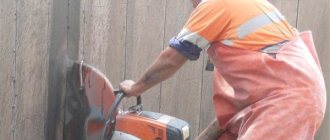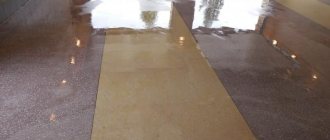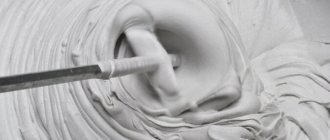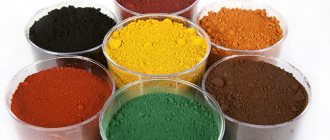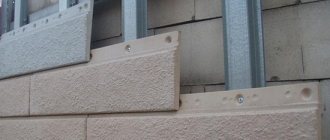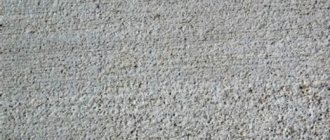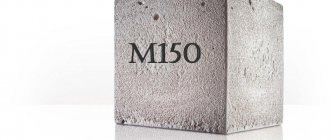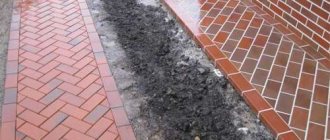Black pigment for concrete: what is it used for
Coloring pigments are widely used in the production of various concrete products, masonry mortar, paving slabs and other structures and structures made of cement mortar and concrete. Black pigment is very popular for its durability and resistance to high temperatures.
Application of black pigment for concrete
Black concrete pigment is used in capital, usually low-rise, construction for coloring masonry mortars and mortar mixtures for other purposes. Also, black pigment for concrete is used in the production of paving slabs, facing stones, reinforced concrete products and in the construction of Small Architectural Forms.
Black pigment gives an almost eternal decorative effect to masonry joints of fences built from “wild” stone and brick walls made of light brick. Considering the relatively low price of black pigment, it is possible to give the building aesthetic appeal and individuality at low financial costs.
The black pigment for concrete is iron oxide, better known among the “common people” as carbon black - soot. This is a dry, environmentally friendly powdery substance with an unlimited shelf life.
Owners of houses equipped with solid fuel stoves know that soot is a very persistent and very difficult to wash off substance. Domestic and foreign industry produces this pigment in the form of powder or granules formed from powder.
The standard packaging is 25 kilogram bags, but on sale you can find half a kilogram package of black pigment made in China. This type of pigment provides excellent uniformity and richness of coloring, and can also withstand temperatures of more than 1000 degrees Celsius without loss of color.
How is black pigment used?
Due to the fact that carbon black (black pigment) is not wetted and does not dissolve in water, it is added to the dry mixture of cement and filler, after which thorough dry mixing and adjustment is carried out until the optimal shade and uniformity of color are achieved.
For mixing at home, it is best to use an electric concrete mixer. The preliminary dosage of pigment is from 3 to 5% of the weight of cement. Important! Adding more than 5% pigment no longer affects the color saturation, but significantly deteriorates the quality of the final product or structure.
In this case, the color saturation of the solution depends on the following factors:
- Amount of pigment;
- Product surface area;
- Mixing efficiency;
- Product surface textures.
Popular domestic and foreign manufacturers
- "PROMINDSA" (Spain). Produces a wide range of black pigments, varying in color saturation. Scope of application: coloring of mortar, brick, cement, concrete, asphalt, glass and other products not related to construction technologies. The average cost of 1 kg is from 110 to 137 rubles. Packing form: bag weighing 25 kg;
- "Taesung" (South Korea). Scope of application: coloring of concrete, mortar, cellular concrete, paving slabs, brick, tiles and sand concrete. Packaging form: paper bag with a polyethylene liner weighing 25 kg. Cost of 1 bag: 4000 rubles;
- "Holliday Pigments" (Russian Federation). For all types of concrete work. Packing: paper bag weighing 25 kg. The average price is from 75 to 90 rubles per kilogram, depending on the selling company.
salecement.ru
Concrete
Decor a la “concrete” appeared (by today’s standards of intensive development) quite a long time ago. But, until today, it was practically not in demand. The victorious march of the gray trend changed the situation. The designers noticed that “concrete” is gray without flaws.
Firstly, color inhomogeneity. Stains, different shades of gray, and heterogeneous structure, characteristic of natural concrete, create a kind of “pattern.” Concrete is devoid of its main drawback - “grayness”. It can be safely used as the main and only color, without combinations.
Decor "concrete"
A kitchen in “concrete” decor looks better than a “pure” gray one
Secondly, like stone, concrete has a certain relief texture. You can play with the decor in combination with smooth matte (glossy) surfaces or natural wood texture.
Combination of concrete texture and natural wood, monochrome color combination
Designers appreciated these advantages and found practical application for them. 2020 can safely be called the year of the victorious march of concrete. By the beginning of 2020, almost all of the world's leading kitchen manufacturers included this decor in their product range. Concrete is the 2020 kitchen trend.
In essence, “concrete” displaces gray and takes its place. As a result, new “concrete” decors appeared that do not exist in nature: gray-beige, “bronze”, etc. In the near future, we think, concrete decors will cover all the main shades of gray.
Leading manufacturers of furniture materials immediately caught the new trend and quickly integrated into it.
For example, the Austrian company Kaindle offered six concrete decors at once, from white to red-brown with a relief surface “Venitian plaster”. At the same time, new decors are implemented both in plastic and laminated chipboard.
As we said above, almost all of the world's leading kitchen manufacturers use "concrete" in their design. Let's look at the most typical solutions and design examples from leading manufacturers. The following companies are represented in the review:
Article rating:
Color gray concreteLink to main publication
Related publications
- Which laminate underlay is best for concrete?
Dyes and pigments for concrete
Concrete is good for everyone - it is strong, cheap, durable, non-toxic, and easy to work with. But its gray color is very dull...
Various concrete dyes are used to improve the decorative effect. There are 2 main methods of painting: add dyes for concrete and mixtures during preparation or paint only the surface, and the main mass is not exposed.
How is concrete painted?
Let's compare these methods:
- • Adding concrete pigment to the mixture is more expensive: it costs more than sand or other components, but a noticeable amount is needed.
- • It's simpler: the pigment is poured into a concrete mixer - as a result, the concrete is colored.
- • The color is distributed throughout the thickness: abrasion of the surface does not reveal the gray concrete, the color of the inner and outer layers is the same.
Mineral paints are used as pigments: natural minerals are crushed and the powder is added to concrete. Ocher is a cheap material mined from quarries that, when cleaned and crushed, colors concrete yellow. In minerals, the most common color carriers are metal oxides and salts. Yellow ocher is iron oxide with clay, red ocher is an oxide.
Artificial paints – processed natural materials – are also used. Firing removes hydrogen, producing red color from yellow ocher. Green and blue colors often produce copper salts, less often cobalt salts. Black dye for concrete is most often obtained on the basis of amorphous carbon, in simple terms - soot.
The best varieties, lamp black, are obtained by burning paraffin in special lamps. But it’s not difficult to make black dye for concrete with your own hands. We carefully burn old tires (we pull the pieces away without letting them burn out) or use soot from the chimney. After grinding, we obtain the desired pigment. Ground red brick added to concrete will change its color to pink.
Application of acid dyes
Acid concrete dyes are used to color concrete surfaces. The surface of concrete products is treated with liquid. The action is closer to staining than to applying a film of paint: the substance penetrates deep into the surface, the acid dye interacts with calcium dioxide already present in the material. As a result, a new colored substance appears. Insoluble, non-removable, colored.
Briefly, the acid dye application technology consists of the following steps.
- • Concrete preparation. Freshly placed concrete is allowed to cure for at least 3 weeks. Grease, dirt, weathered parts or places where water has flowed down old concrete make the result unpredictable. Needs sanding or sandblasting. Keep in mind that the wheels from grinding machines will become more noticeable after painting! When laying the top layer, it is good to use concrete on white cement or to “iron” it over the wet layer until the main mass hardens. Before painting, wash off the sawdust. We do not use acidic cleaning products. Dry it.
- • We structure the surface over wet concrete, if your plans provide for this procedure. There are special flexible matrices that we cover the surface to obtain the texture of tiles, “cobblestones,” “torn stone,” or anything else you need. You can make them yourself from polyurethane foam. Or even print with a lump of plastic film.
- • We cover the area nearby - with film, shields, masking tape.
- • Apply the coloring solution. The ongoing reaction, hissing, is normal, as it should be. Leave for at least 6 hours. We make sure that liquid does not stagnate in depressions or cracks, if this is not provided for in your plans.
- • Wash everything off with cold water.
- • If necessary, apply a second layer. Only after the first one has dried.
Factors influencing the final result
When painting by any method, the final result depends on many factors:
- • Coloring ability of the pigment.
- • Amount applied.
- • Precise cement composition.
- • Concrete aggregates used.
- • Hardening mode.
- • Humidity and temperature of concrete, if we paint it and do not add it to the mixture.
- • Penetration ability, which largely depends on the pore size and other difficult to determine factors.
It is very difficult to accurately guess, let alone calculate in advance, the shade obtained as a result of the addition of powder dyes during the production of concrete. It doesn’t matter what we do – paving slabs, borders, colored sculptures or anything else. It is no easier to calculate the result when painting old concrete. It’s even more complicated: the color at the end of the reaction is different, and not a mechanical mixture of the color of the dye and the base.
Therefore, it makes sense to first try it in an inconspicuous place, to make a test. Then adjust the actions - add/subtract the number of components, mix several pigments, make changes to the process. It is clear that the more work experience, the more accurately the result corresponds to the intended one.
Similar articles
| Analyzing the graph of concrete strength gain B 25, we can say with confidence that at a temperature of 30 degrees above zero Celsius, concrete will reach its strength of 60% in approximately 65 hours. And at a temperature of +80 degrees Celsius the same strength will be... |
| The characteristics of polystyrene concrete include low thermal conductivity. Wall masonry made from this material is made using a special glue, which is an analogue of the usual cement mortar that holds the interblock joints together. In addition, it is possible to erect monolithic structures from the specified type of blocks. This material, I found a variety of… |
| To improve the decorative properties of concrete, pigments or acid dyes are usually used. The latter are applied to the surface of concrete products, and the result of the interaction of the dye with the base is a new insoluble...... |
| A decrease in the solubility of cement released during hydration is how concrete hardening accelerators work. Next, hydration of clinker minerals occurs and the number of new formations in the cement stone changes upward. Therefore, the strength of concrete that contains an accelerator increases significantly in the first 3-7 days... |
promplace.ru
INTEK - we produce equipment for your business!
2.1. The color of cement and its effect on the color of painted concrete.
Portland cement comes in various shades of gray. Gray color mutes all other colors and shades. Therefore, when painting concrete that is produced on the basis of ordinary Portland cement, it is impossible to achieve the brightness and richness of color that can be achieved with white cement.
The degree of saturation and purity of color obtained from white cement also depends on the color of the pigment itself. In the case when black pigment is used, gray cement painted with it is practically no different from concrete painted with white cement. In the case of red-brown pigment, this difference is insignificant. When it comes to green, blue and especially yellow pigments, the differences can be dramatic. The higher the purity of the desired shade, the lighter it is, the greater the need to use white cement.
It must also be taken into account that in practice the color of gray cement varies from light gray to dark gray. Changing the type of cement or supplier often leads to a change in the final color of the concrete obtained after painting. The reason for this is the difference in the original color of the cement.
2.2. Fillers.
When producing colored concrete, filler particles are enveloped in a colored cement binder. In this case, it may happen that the filler particles are not completely covered, which leads to the influence of the color of the filler on the final shade of the concrete. The influence of the color of the filler on the shade of concrete is even more noticeable due to atmospheric exposure, when the grains of the filler appear more clearly on the concrete surface. In this case, a visual mixing of colors occurs. The same color of sand has a similar effect on light tones of concrete (yellow, blue, green). This impact is significantly reduced when it comes to brown or black concrete.
2.3. The influence of the amount of pigment on the quality of colored concrete.
Information about the optimal amount of pigment required to obtain the desired result helps to save money, since in this case there will be no overuse of an expensive (compared to other components) product. As the pigment part in the composition increases, a linear increase in color intensity is achieved. With a further increase in the amount of pigment, a moment comes when no change in color intensity is observed. It is from this moment that increasing the proportion of pigment in the mixture becomes economically unprofitable. The recommended upper limit for the use of pigments in concrete mixtures based on gray Portland cement is limited to 6% of the pigment by weight of the binder. Most often, 3-5% is administered. In the case of using less intense pigments, the saturation limit is reached when adding significantly more pigment. However, it may happen that the amount of pigment required to obtain the desired result will increase to such an extent that it will entail negative consequences in the form of a deterioration in the technological characteristics of concrete (this occurs when the proportion of pigment increases above 10% of the mass).
2.4. Water-cement ratio and concrete color.
Excess mixing water evaporates from the concrete, leading to the formation of small pores that scatter the incident light and brighten the concrete. The higher the water-cement ratio, the lighter the concrete appears. The influence of this factor on the difference in shades can be almost completely eliminated by careful adherence to concrete preparation technology.
2.5. The color of concrete depends on the cement content.
When painting concrete, it is not the filler that is painted, but the cement binder, which, in turn, covers individual particles of the filler. The more the colored cement binder is diluted with filler, the less saturated the final color of the concrete becomes. At the same level of pigmentation, concrete with a high cement content has a significantly more intense color than concrete with a low cementitious content.
www.intext.ru
Gray kitchen
Let's talk about trends. Gray color is one of the main trends that finally took shape by 2014-2015.
Gray color is not included in the color wheel, but forms its own group of colors - achromatic (colorless). Shades of gray depend on the percentage of white or black. Black and white are the “extremes” of gray. Gray is considered a neutral color and goes well with any color on the color wheel.
Good designers know the “golden rule” - when you can’t decide on the color of the countertop, choose gray.
However, despite its versatility, gray has only recently become a trend. Some might think that the color owes its popularity to the acclaimed film “50 Shades of Grey.” From our point of view, the reasons for popularity are not related to sadomasochism, but are on a different plane.
- Firstly, the increased popularity of natural wood is to blame: smooth facades in classic and modern styles with a tangential wood pattern. White, beige and gray colors go well with the beige palette of natural wood.
Combination of dark wood decor and gray-beige (2 tones lighter)
- Secondly, another trend is to blame - tinting wood in gray colors: from light gray to black-brown. In this case, a monochrome combination with gray of the same shade, or 1-2 shades darker (lighter) is considered ideal.
Combination of wood decor with gray color
One of the most popular decors is oak in gray tinting.
These two trends formed the third, “gray” trend.
However, gray is not without its drawbacks. A kitchen made in one gray color looks quite dull and “gray”.
Gray kitchen looks "gray"
And it looks completely different when combined with other colors.
The combination of gray and red is considered classic
Dark gray and rich yellow are the trend of recent years
Gray goes with any color, even green.
Gray and blue look great
